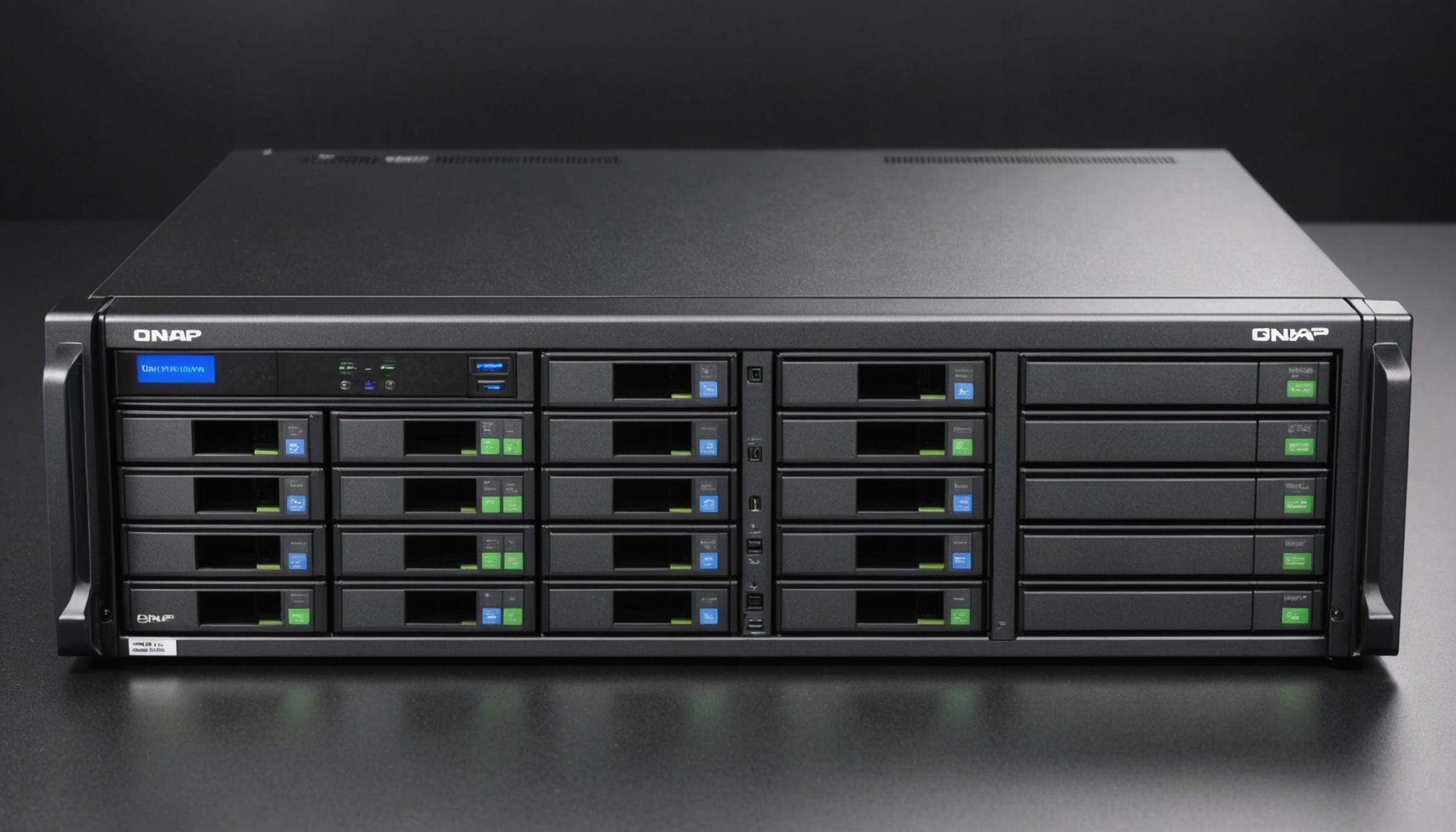Understanding RAID Configurations
In the world of storage, RAID configurations play a pivotal role in enhancing performance and ensuring data redundancy. For small businesses, implementing the right RAID setup can maximize storage optimization and improve efficiency. The QNAP TS-673A, a popular NAS system, often utilises these configurations to meet varying storage needs.
RAID (Redundant Array of Independent Disks) is a technology that uses multiple disks to provide better data reliability. Various RAID levels exist, each with distinct characteristics. For example, RAID 0 offers improved performance by striping data across drives but lacks redundancy. On the other hand, RAID 1 mirrors data for reliability, sacrificing some storage efficiency.
Have you seen this : Unlocking Peak Performance: Creating an Isolated Virtual Environment on Your HP ProLiant DL380 Gen10 for Enhanced Multi-Application Efficiency
Choosing among these RAID configurations involves weighing advantages and disadvantages. RAID 5, which stripes data with parity, balances performance with redundancy but can be slower in write-intensive environments. RAID 6 provides additional fault tolerance but at the cost of further efficiency.
Each level is tailored for specific needs, making understanding RAID levels essential. By grasping these intricacies, small businesses can make informed decisions, ensuring their NAS systems, like the QNAP TS-673A, align with their data storage strategies and operational demands.
Also read : Unlock the Full Potential of Your Alienware Aurora R11: Enhance Gaming Performance with a GPU Upgrade!
Choosing the Right RAID Level for Your Business Needs
When selecting RAID level for your business, it’s crucial to align with your specific business storage needs and the nature of the data you handle. Understanding the unique requirements of your operations can guide your choice. For instance, NAS systems used in industries with heavy data access and high availability demands may benefit from RAID 5 or RAID 6, which offer a balance between performance and redundancy.
Evaluating the performance, redundancy, and scalability of various RAID levels can lead to a well-informed decision. RAID 0, for example, enhances speed but lacks fault tolerance, making it suitable for environments where data loss risk is minimal. Conversely, RAID 1’s mirroring technique offers high data protection, albeit with lower storage efficiency, making it ideal for industries where data integrity is paramount.
Different business sizes and data types necessitate specific RAID choices. For large databases or video editing, RAID 6 can handle heavy workloads with enhanced redundancy. On the other hand, smaller businesses with moderate data access requirements may find RAID 1 sufficient. Prioritizing specific factors like speed, capacity, and data protection will ultimately ensure your NAS system is effectively optimized for your business operations.
Step-by-Step RAID Configuration for QNAP TS-673A
Configuring the QNAP TS-673A with the right RAID configuration can enhance your NAS’s functionality. Here’s how to get started.
Preparing for RAID Setup
Before diving into the NAS setup guide, ensure your drives are ready and compatible. It’s crucial to consult the QNAP compatibility list for your storage drives to avoid potential issues. Before placing the drives into the QNAP TS-673A, confirm they are free from defects or errors by running diagnostics.
Initial QNAP TS-673A Configuration
Once your drives are ready, power on the QNAP TS-673A and connect it to your network. Access the QNAP configuration interface via a browser, usually accessible at http://qnap-nas:8080 or by using QNAP’s utility. Initial setup involves assigning an IP address, configuring network settings, and setting a strong administrator password to secure access to the system.
Configuring RAID in QNAP Interface
Navigate to the RAID configuration steps within the QNAP dashboard. You can select from various RAID levels that suit your storage needs. For example, a business requiring greater redundancy may opt for RAID 6, while those focusing on speed might choose RAID 0. The QNAP interface offers a step-by-step guide to finalize your chosen RAID array, ensuring your QNAP TS-673A is optimized for your storage requirements.
Performance Optimization Techniques for RAID
Optimizing RAID performance is paramount for achieving efficient data access and management, especially with systems like the QNAP TS-673A. A key focus area includes enhancing read and write speeds. Start by implementing caching strategies, which can significantly impact performance by storing frequently accessed data for quick retrieval. Proper cache configuration can reduce latency and improve throughput.
Additionally, it’s crucial to fine-tune your NAS settings. QNAP performance tuning offers several tools and methods to monitor and enhance your RAID setup. Regularly updating firmware and software can prevent bottlenecks and ensure your system runs smoothly.
Monitoring is another essential aspect. Utilize performance monitoring tools to keep track of RAID health, enabling proactive maintenance and quick identification of potential issues. Performance anomalies can often indicate underlying problems that need addressing before they escalate.
Also, consider adapting optimization strategies to your specific workload needs. For instance, adjusting block size or implementing striping can boost performance for applications that demand high data access speeds.
By focusing on these optimization strategies, businesses can maximize their RAID’s potential, ensuring swift and reliable data operations. This proactive approach not only improves performance but also extends the lifespan and efficiency of your storage solutions.
Troubleshooting Common RAID Issues
Encountering problems with RAID configurations is surprisingly common, even with advanced QNAP systems. Recognising early signs of issues can prevent severe data loss. Indicators such as unexpected system reboots, decreased storage performance, or error messages in your QNAP dashboard may hint at RAID degradation.
When faced with RAID troubleshooting, start with fundamental checks. Ensure that all drives are correctly seated and powered. Swap cables or ports if necessary to rule out hardware faults. If further issues persist, engage QNAP’s built-in diagnostic tools. These tools help identify failing drives or corrupt RAID arrays.
Common issues often arise from improper setup or drive failures. With QNAP’s support readily available, utilise their online resources or direct assistance if needed. Accessing QNAP’s official support can offer tailored solutions and guides to resolve persistent problems.
For a more hands-on approach, initiating a RAID rebuild or recovery through QNAP’s interface can be beneficial. However, always back up critical data before attempting more invasive recovery steps.
By proactively addressing these common RAID issues and utilising available support resources, businesses can preserve data integrity and maintain optimal NAS performance.
Use Cases and Real-Life Applications of RAID in Small Businesses
RAID use cases in small businesses demonstrate the technology’s utility in various scenarios, offering small business storage solutions that ensure data reliability. One common application is in graphic design firms, where RAID 5 is utilised to balance performance with redundancy, safeguarding large image files while supporting quick access and retrieval.
Similarly, healthcare clinics benefit greatly from RAID 1 or RAID 10 configurations, prioritising data protection and quick recovery of sensitive patient information. These setups allow continuous data access, essential for maintaining medical records’ confidentiality and integrity during outages or drive failures.
In retail, RAID configurations such as RAID 6 can manage extensive point-of-sale data and customer databases, ensuring uninterrupted operations during peak sales periods. With RAID’s capability to handle multiple drive failures, businesses can confidently protect transaction data against unexpected hardware issues.
Data recovery scenarios often involve using RAID arrays to reconstruct lost files efficiently. RAID 1, with its mirroring feature, provides a straightforward method of data retrieval by simply accessing mirrored drives.
Future-proofing your storage setup with RAID involves planning for scalability, ensuring that storage infrastructures evolve alongside business growth, accommodating increasing data volumes and complexities without compromising accessibility or security.
Visual Aids and Resources for Understanding RAID
Understanding RAID configurations can be complex, yet visual aids substantially clarify these storage concepts. Diagrams depicting RAID levels illustrate how data is distributed across drives, highlighting differences in performance and redundancy. RAID diagrams serve as a valuable tool for visual learners, making it easier to grasp how each configuration manages data.
Leveraging available QNAP resources can further enhance understanding. QNAP offers comprehensive educational materials, including guides, tutorials, and webinars. These resources delve into RAID configurations, providing step-by-step instructions and insights into optimizing your NAS setup. Engaging with QNAP’s community forums also provides real-world advice and solutions from fellow users, enhancing understanding through shared experiences.
For those eager to dive deeper into RAID’s intricacies, several books and online courses are available. These educational materials give in-depth explanations of RAID technologies and their applications in various business contexts. They also cover troubleshooting and optimization, providing a robust understanding of RAID systems.
By utilizing a combination of visual aids and these resources, users can deepen their knowledge of RAID configurations, ensuring effective application in their storage systems. This comprehensive approach aids in better configuring and maintaining efficient NAS solutions tailored to business needs.










